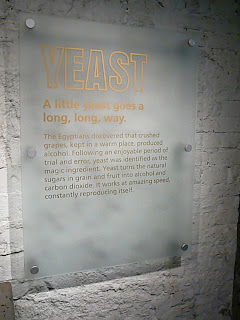The
final Ireland post!! It might be a bit long, but it’s all contained here. Remember...click on the pics to enlarge!! J
On our
first day, we visited Trinity College and the Book of Kells! A couple pieces of
background information – I’ve been practicing calligraphy for about 10 years
now. I wrote a paper on the style of ornamentation in the Book of Kells. And
this was one of the MAIN reasons why I wanted to come to Ireland in the first
place!!!! (So, as you can imagine, I was really only moderately excited to see
this manuscript in person…;-)
 |
| Trinity College campus. |

The
exhibit, “Turning Darkness Into Light,” explores illuminated manuscripts in
general, but the Book of Kells is the obvious highlight. It is one of the most
lavishly illuminated manuscripts in existence (and definitely the most ornamented
Gospel book in the British Isles). Some interesting points:
- Created
ca. 800
- Survived
numerous raids by Vikings (900 was a BAD year)
- Was
presented to Trinity College in 1661
- Ornamentation
is based on pre-Christian, “pagan” motifs (especially interlacing knotwork,
spirals, and animals)
These are the two decorated pages we saw (there were also two text pages):
 |
| Portrait of St Matthew (folio 28v)
|
 |
Liber generationis, opening words of
St Matthew’s Gospel (folio 29r)
|
At the end of the
exhibit, we got to look at the pages. They are quite dark with age, but an
amazing amount of detail has been preserved. You can see the minutest
decorations…:-D We couldn’t admire the pages for long, though – you take your
turn quickly, and let the next visitor take your place…:-S
We also passed through
the Long Room of the oldest library at Trinity. Now that’s MY idea of a library…(cough…Taylor
Digital Library, U of C…;-)
Since we still had the
car, in the afternoon we drove to Newgrange. Newgrange itself is the name of a
prehistoric monument called a “passage tomb”, which is a huge mound of earth containing
one or more passages leading to inner chambers at the centre. The passages themselves
are often aligned so that the sun shines into the passageway at significant
times of the year, such as at the winter solstice or the equinoxes. However, Newgrange is only one passage tomb in the surrounding
area of Brú na Bóinne (containing many other tombs, standing stones, and henges).
It’s one of Ireland’s UNESCO World Heritage Sites.
 |
| Side of Knowth large passage tomb. |
 |
| Smaller "satellite tombs" around the large passage tomb. |
 |
| Newgrange seen from a distance. |
 |
| The large passage tomb at Knowth. |
The tour to the
Newgrange tomb was full (it’s more famous and you get to walk inside), but we
signed up to visit Knowth, which even larger than Newgrange. I think the highlight
of the trip was seeing the huge array of Neolithic art. The stones surrounding
the large passage tomb all had abstract designs that are amazingly
well-preserved.
 |
| Neolithic art! |
 |
| The passage inside (not safe for public). |
The large tomb has two
passages leading to inner chambers. Archaeologists have found cremated remains,
suggesting that this was a ritualistic or sacred area rather than a mere tomb.
Over time, the entrances to both passages were blocked, and later generations
built structures on top of the mound, since the hill allowed a commanding view
over the countryside. Major excavations of Knowth began in 1962.
 |
| If the bus says it, can we say we've been there? |
The rest of our trip was
more relaxed – we spent a lot of time walking around the city. I met up with my
friend C, a fellow violist who is originally from Dublin but whom I first met
in Graz. We went to her orchestra’s concert on the Saturday, which was a lot of
fun! (They played excerpts from “The Planets”…J)
 |
| Fancy breakfast at the Queen of Tarts! |

 |
| Christ Church Cathedral. |

 |
| On the bus. |
 |
| The Molly Malone statue. |


 |
| St. Patrick's Cathedral Gardens. |

 |
| Downtown Dublin. |
 |
| A and the River Liffey. |
 |
| The River Liffey from O'Connell Bridge. |
We also visited:
- The Kilmainham Gaol – A prison
established in 1796 in the hopes of replacing the old jail and its squalid,
overcrowded conditions. However, Kilmainham also became overcrowded, with no
gender segregation. Many prisoners were deported to Australia, and during the
potato famine of 1845-1852, some people committed petty crimes just to receive
the jail’s scanty (but regular) meal portions. Many political prisoners during
the 1916 Easter Rising were jailed here.


 |
Many filmmakers have used this
as a set (Italian Job, anyone?) |

- The Guinness Factory –
The #1 Dublin attraction! My favourite parts were seeing how they make the
beer, and watching the art of cooperage (wooden barrel-making).























































No comments:
Post a Comment